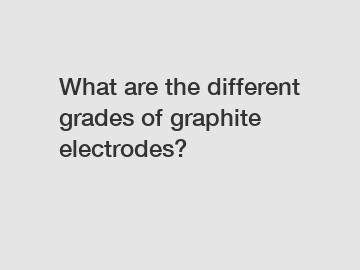Jan. 14, 2024
Minerals & Metallurgy
For more information, please visit KFCC.
What are the different grades of graphite electrodes?
Graphite electrodes play a crucial role in industries such as steelmaking and aluminum production, where they are used in electric arc furnaces. These electrodes provide the necessary electrical conductivity and heat resistance to sustain high temperatures and facilitate chemical reactions. However, not all graphite electrodes are created equal. They come in different grades to suit various industrial requirements. In this article, we will explore the different grades of graphite electrodes and their unique characteristics.

1. Regular Power (RP) Grade:
Regular Power graphite electrodes are the most commonly used type. They offer moderate electrical conductivity and thermal resistance, making them suitable for a wide range of applications. RP electrodes are typically utilized in steelmaking, where they can withstand the intense heat and high current densities necessary for melting scrap metal and producing high-quality steel. Due to their versatility and relatively lower cost, RP electrodes are a popular choice for many industries.
2. High Power (HP) Grade:
High Power graphite electrodes are designed to withstand more extreme conditions than RP electrodes. They possess higher levels of electrical conductivity and thermal resistance, allowing them to handle higher current densities and temperatures. HP electrodes are mainly used in electric arc furnaces for steelmaking, particularly in processes that require intensive power inputs and shorter production cycles. The improved performance of HP electrodes comes at a higher cost, but their ability to withstand demanding environments justifies the investment for many steel producers.
3. Ultra High Power (UHP) Grade:
Ultra High Power graphite electrodes represent the top tier of performance in this category. UHP electrodes are engineered to endure the most extreme operating conditions encountered in modern steelmaking. They exhibit exceptional levels of electrical conductivity and thermal resistance, enabling them to withstand intense heat, high current densities, and prolonged operation durations. UHP electrodes are particularly suitable for electric arc furnaces utilizing ultra-high power inputs and fast melting cycles. Although UHP electrodes are the most expensive among the different grades, their outstanding performance and durability make them a preferred choice for highly demanding steelmaking operations.
4. Nipple and Nippleless Electrodes:
Aside from the different grades, graphite electrodes also differ in terms of their nipple and nippleless designs. Nipples are small cylindrical studs attached to the electrode, allowing for electrical connections within the furnace. Nippleless electrodes, on the other hand, have a tapered end that directly interfaces with the furnace. Both designs have their advantages and are chosen based on factors such as furnace type, operational requirements, and electrode lifespan.
In conclusion, the different grades of graphite electrodes are tailored to meet the diverse needs of various industries, specifically in steelmaking and aluminum production. Regular Power electrodes offer moderate performance at a reasonable cost, making them widely used. High Power electrodes provide improved characteristics for more demanding applications, while Ultra High Power electrodes deliver top-tier performance in extreme operating conditions. Both nipple and nippleless electrode designs also offer flexibility based on specific furnace requirements. By understanding the different grades and designs available, industries can choose the most appropriate graphite electrodes to enhance their overall production efficiency and output quality.
For more information, please visit 600mm Hp Graphite Electrode.
Previous: Which Drill Collar Exporter Offers the Smoothest Performance?
Next: Which Alternative Uses for Copper Mesh Wire Can Revolutionize Your Home Décor?
If you are interested in sending in a Guest Blogger Submission,welcome to write for us!
All Comments ( 0 )